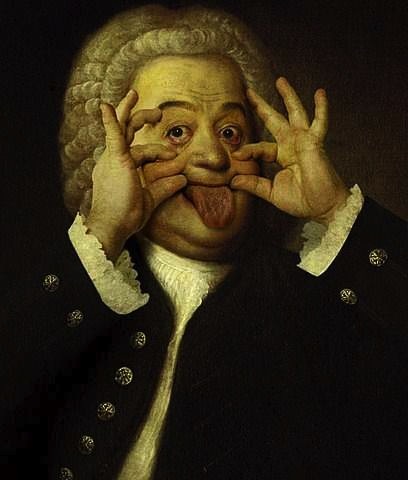
TO: lolitalark@yahoo.comFROM: Jon Gallant
RE: Johann Sebastian Bach
Somewhere in RALPH, one of its stable of contributors (either Ignacio Schwartz or Lolita Lark, I think) commented on how puzzled the good burghers of Leipzig must have been every Sunday at the weird, visionary music of Herr Bach, the kapellmeister. I have to take issue with this notion, to some extent.First of all, Bach enlivened the Sunday services at St. Thomas with more than just music. Take the following account:
The new rector of the Thomasschule, Johann August Ernesti, claimed that it was his right to appoint prefects (those who acted as Bach's assistant music directors and teachers). Ernesti, a man who had no musical taste or talent whatsoever, wrote an avalanche of letters to the town council complaining about Bach's output and performance. Contemporary accounts from this period describe shouting matches in church services where Bach would remove one of Ernesti's appointees and substitute one of his own.
Another of Bach's feuds was with an organist named Görner: "It is reported that on one occasion Bach became so upset with Görner's playing that he snatched off the man's wig and threw it at him." In short, Sunday services in Leipzig during Herr Bach's tempestuous time there seem to come right out of a Marx brothers movie.
Moreover, although the tone-painting in Herr Bach's weekly cantatas was unparalleled, the musical idiom he employed was relatively conventional, even a little old-fashioned. I think the good burghers of Leipzig were probably more bemused by the Sunday shouting matches and flying wigs than by the music.
It was in his instrumental rather than choral music that Bach ventured into regions far ahead of his time. Some of the organ toccatas and fugues reveal a fantastic imagination. Parts of the Musical Offering sound as if they were written in the 20th century. And the Well Tempered Clavier, that bible of serious music, seems to span everything from the Baroque through the Romantic right to the Modern.
Two of the pieces in the Well Tempered Clavier have themes which would be described as 12-tone rows, when Arnold Schoenberg thought he had invented that concept 180 years later. The crucial difference is that Bach brilliantly integrates the 12-tone chromatic theme into the standard key system (even though any one key contains only seven of the 12 tones). Schoenberg used the 12-tone row instead to escape the key system entirely, resulting in a form of music with no topography: it is never going to or coming from any definable point. The resulting aimless mishmash was so unlistenable that Schoenberg's system was abandoned by everybody about a generation ago. Herr Bach's music, on the other hand, has the remarkable property that it was modern three centuries ago, and still is.
--- J. Gallant